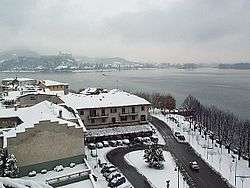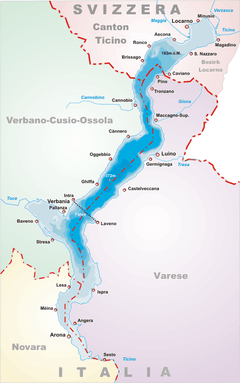Arona, Piedmont
| Arona | ||
|---|---|---|
| Comune | ||
| Città di Arona | ||
|
Largo Garibaldi in winter. The castle in the background is Angera. | ||
| ||
 Arona Location of Arona in Italy | ||
| Coordinates: IT 45°45′N 08°33′E / 45.750°N 8.550°ECoordinates: IT 45°45′N 08°33′E / 45.750°N 8.550°E | ||
| Country | Italy | |
| Region | Piedmont | |
| Province / Metropolitan city | Novara (NO) | |
| Frazioni | Campagna, Dagnente, Mercurago, Montrigiasco | |
| Government | ||
| • Mayor | Alberto Gusmeroli (since March 30, 2010) (LN) | |
| Area | ||
| • Total | 14.90 km2 (5.75 sq mi) | |
| Elevation | 212 m (696 ft) | |
| Population (31 December 2010) | ||
| • Total | 14,547 | |
| • Density | 980/km2 (2,500/sq mi) | |
| Demonym(s) | Aronesi | |
| Time zone | CET (UTC+1) | |
| • Summer (DST) | CEST (UTC+2) | |
| Postal code | 28041 | |
| Dialing code | 0322 | |
| Patron saint | Sts. Felinus and Gratian | |
| Saint day | March 13 | |
| Website | Official website | |
| Wikimedia Commons has media related to Arona. |
Arona (Italian pronunciation: [aˈroːna]; Aruna [aˈruna] in Western Lombard) is a town and comune on Lake Maggiore, in the province of Novara (northern Italy). Its main economic activity is tourism, especially from Milan, France and Germany.
History
Archaeological findings have shown that the area of what today is Arona was settled from the 18th–13th centuries BC. Later it was a possession of the Celts, the Romans and the Lombards.
In the 11th century the Benedictine abbey of Saints Gratianus and Felinus, Martyrs, was founded.
After the siege and destruction of Milan in 1162 by Emperor Frederick Barbarossa, many of the exiled took refuge in Arona.
Later the city was a possession of the Torriani and (from 1277) of the Visconti families. In the early 14th century the city became a free commune under the suzerainty of the abbey. In 1439 it was acquired by Vitaliano Borromeo and, as a result, the House of Borromeo.
Main sights
Arona's main attractions include:
- Sancarlone. This giant statue of Saint Charles Borromeo was commissioned by Cardinal Federico Borromeo, and construction began in 1614, completed in 1698. At 35.10 metres (115.2 ft) it was the largest bronze standing statue in the world, still second only to the Statue of Liberty. It is said that the architects behind the Statue of Liberty consulted the blueprints of the Sancarlone when laying out their own. The statue was intended as part of a complex of buildings and chapels celebrating the life of St. Charles, of which only three chapels were completed. Next to the statue are the 17th-century basilica and the former Archbishop's Palace. A smaller version of the statue, the Sancarlino, can be seen in Corso Cavour in the town.
- La Rocca ("The Castle") is a park owned by the Borromeo family. The park used to contain the castle of Arona, destroyed by the Napoleonic armies, and was the birthplace of St. Charles Borromeo himself. The park is freely open to the public and is a favourite of many locals; many animals are kept in semi-captivity in various areas of the park.
- The Lungolago ("Lakeside") offers a fine view of the castle on the opposite shore, the Rocca Borromeo di Angera, and the Alps. Swimming in Lake Maggiore is now possible, after years of pollution. A beach has been refurbished by this group close to Piazza del Popolo in the town centre, called Le rocchette ("The little rocks").
- Collegiata della Natività di Maria Vergine (1482) - church has paintings of the life of the Virgin Mary by Pier Francesco Mazzucchelli, also known as Morazzone.
- Santi Martiri
The frazione of Mercurago is home to Lagoni Park, a protected area including a peat-bog, pastures dedicated to the breeding of thoroughbred horses and a woodland area. There are also some archeological findings from the Bronze Age, including ancient wheels.
Transport

Arona is 25 kilometres (16 miles) north of Milan's Malpensa International Airport, actually closer than Milan itself. It is also connected to the railway network, being one of the main stops in the important link between Milan and Switzerland that passes Domodossola (another parallel link travels through Como). Arona is also the last station for two minor rail lines, connecting Arona to Novara and to Santhià; the latter uses single-car diesel trains.
Due to the town's size there is no public transport, but some bus companies connect the city to its frazioni of Dagnente, Campagna, Mercurago and Montrigiasco, and to neighbouring municipalities.
Arona is near a confluence of motorways, and from there one can head for Milan, Genoa, and Gravellona Toce (where the motorway becomes a simple highway to Domodossola and continues into Switzerland). Whereas there is a motorway exit named after Arona, the exit at Castelletto Ticino is usually more convenient for the traveller coming from the direction of Milan.
The headquarters of Navigazione Lago Maggiore (Lake Maggiore's ferry company) are located in Arona, along with its shipyard. Arona is the southernmost port on Lake Maggiore, and transport by boat or hydrofoil is available to both sides of the lake up to the Swiss city of Locarno.
Surrounding municipalities
Twin towns – Sister cities
Arona is twinned with:
External links
- Official website
- Arona.net, a private portal
- AronanelWeb, history and events of the city
- Discover Arona, Local information
![]() Arona travel guide from Wikivoyage
Arona travel guide from Wikivoyage


